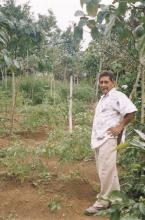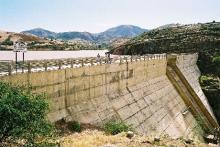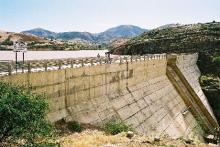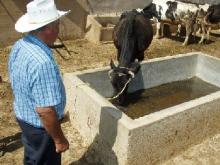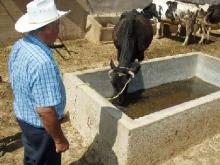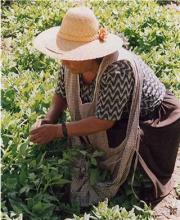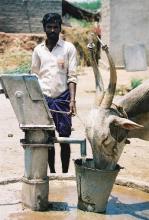Livelihoods
02. A multi sectoral approach to sustainable rural water supply: the role of the rope handpump in Nicaragua
J.H.Alberts and J.J. van der Zee (2004)
A low cost rope handpump for boreholes and hand-dug wells up to 70 m deep has been developed, marketed, and subsequently mass-produced in Nicaragua by local, small, privately-owned workshops since the early 1990’s. It is easy to maintain and highly efficient at the family- as well as community level.
The pump has met with high social acceptance amongst rural users ever since the early, rudimentary models were first made available. By 1995 the technology became an integral part of rural water programmes implemented by NGOs and government agencies. Rural water supply coverage since then has doubled from approximately 27.5% to 54.8%. Of this 27.3 percentage point rise, rope pumps account for 23.6% (or 85% of the total increase).
The income generating capacity of the rope pump has been an important reason for its acceptance and successful introduction. In addition credit schemes linked to the introduction of the pumps have proven successful, whilst comparative studies of farm income show that families with a rope pump generate an average US$225 of additional annual income which can represent up to 50% of the total income for the lower income groups.
Production of the technology by about a dozen private workshops has made Nicaragua the country with the highest handpump density per rural capita. Though broad international interest has been received, inclusion of the technology in rural water supply programmes on other continents has encountered serious institutional barriers. Widespread introduction elsewhere requires a multi sectoral approach in a context somewhat broader than the policies of the traditional Water and Sanitation sector. In particular, the impact of income generation on sustainability should be understood and capitalised on, whilst alliances with the private sector are required for promotion and production. Collaboration across boundaries between poverty reduction initiatives and the water supply sector are fully justifiable.
However, symbiosis between the private sector user and private sector producer is the essential foundation to make development an economically viable proposition.
Entitled 'Recognizing reality: multiple use of rural water supply systems', this case study documents the experience of some areas in Cali in meeting the multiple demand and need for water in rural areas. The study is entered into with an understanding that there is a strong demand for small-scale productive use of water and that all too often, water supply systems are designed to only meet domestic demands. Based on the findings of the case study, experiences in Cali reflect the importance of developing integrated solutions to people's water needs and the push for institutional innovation and design to bridge the needs of the reproductive and productive domains.
This case study on household level productive uses of water in Bolivia focuses on two key issues:
- The importance of productive activities in household water use, and the associated contributions water makes to livelihoods, and
- The potential for water resources conflicts over allocations for household level productive uses.
The case study was carried out around the rapidly growing city of Cochabamba in central Bolivia. The study areas were Tarata, a small town to the south-east, and Tiquipaya, which is located on the peri-urban fringes of the city.
Household water use patterns
One part of the case study involved investigation of household water-use patterns in Tarata and Tiquipaya. This research examined the multiple use of domestic water supplies, and the use by families of multiple sources to meet their water needs for both domestic and productive activities. As the city of Cochabamba expands, it is argued by the authors that productive water uses such as irrigation of gardens ( huertas) are likely to make significant demands upon new domestic water supply systems. These uses are equally likely to have an important impact, whether positive or negative depending on your viewpoint, on the overall availability of water resources as well as on the livelihoods of urban and peri-urban water users.
Key findings
- At the household level, studies show that a significant proportion (roughly half) of so-called ‘domestic’ water supplied in Tarata and Tiquipaya was used by the case study families for productive activities: including irrigation of huertas, watering livestock or other enterprises. Equally, irrigation water is used, at times, for domestic purposes.
- In some cases domestic water provides the sole source and makes small-scale irrigation of huertas or other enterprises possible. More often domestic water provides an important supplementary source and reduces risks in irrigated cropping where canal water is inadequate or unreliable. In general, non-domestic sources provided a far greater quantity of water for productive purposes, but the strengths of domestic water supplies are their availability (often 24 hours a day), reliability, and convenience.
- The need for multiple uses was recognised by the water supply utility in Tarata who in addition to supplying safe water from groundwater sources through the domestic network, sought to supply additional (and cheaper) water for urban and peri-urban agriculture through a system of canals. Similarly, the designers of the proposed EPSA-Macoti water and sanitation system in Tiquipaya should take account of the relatively high demand (and potential) for the use of domestic water for productive activities in Tiquipaya and the need to plan in an integrated way for multiple uses from multiple sources. Otherwise, opportunities to support livelihoods will be lost and high per capita use of water for productive activities may compromise supplies in other tail-end parts of the system.
Conflict over water allocations
The second part of the case study investigated a serious conflict in Tarata over allocations of water for household level productive uses around the town. Disputes came to a head in 2002 over the rights to use water for urban and peri-urban agriculture from a multiple purpose water supply system (Laka Laka). The Laka Laka dam was planned to provide water for a large irrigation scheme and to meet the basic needs of domestic users in the town, but not specifically for productive water uses within the urban area.
Almost 5% of the estimated reservoir yield (or 10% of the storage capacity) was originally allocated for urban water supply, but this could not be used as drinking water due to the poor water quality and high costs of treatment. The urban community organised to utilise this water, on the basis of advice they received from local government supporting their proposals, for irrigation of huertas instead. An organisation was formed to develop the infrastructure to supply this water to huertas. However, there were violent conflicts with farmers from the irrigation scheme ( regantes)who were determined to protect their irrigation water rights.
Key findings
- The use of water from the Laka Laka reservoir for urban agriculture was in the opinion of the regantes, against the agreed rules for operation of the multiple purpose scheme. The construction of a pipeline to irrigate huertas in the town and renewed use of the water from the dam by the town after a gap of four years was a direct cause of the conflict, aggravated by the lack of overarching legislation and norms, and the historic rivalry between the municipalities of Tarata and Arbieto (where much of the irrigated land is located).
- The declining yield of the reservoir due to severe sedimentation is likely to lead to further pressures on the scarce water resources in the area, and potentially continued or more serious conflict, unless strong institutions are able to manage the diminishing resource and resolve the conflicting interests. Potential solutions to help minimise or resolve the existing conflict in Tarata could include better information sharing between key stakeholders (including reliable information on declining future water availability due to sedimentation), more transparency in the operations of the key institutions, general strengthening in institutional capacities to deal with conflicts, and in the irrigated areas especially, measures to introduce incentives to use water more efficiently.
- Although every conflict over access to contested resources has many local characteristics, some more widely applicable lessons can be learnt from the disputes in Tarata. Firstly, improved domestic water supplies, in this case following construction of a reservoir and associated infrastructure, will in certain cases lead to increased water use for urban agriculture and other productive uses. Secondly, productive water uses at the household level are, as in Tarata, rarely considered in planning. These needs should be properly considered in the project design for improved water supplies and multi-purpose projects, and the rights to water for these uses should be clearly negotiated and agreed in multiple-purpose projects.
- Whether urban agriculture, or other productive uses of water around homesteads, should be explicitly encouraged within domestic or multiple-purpose water supply projects should amongst other factors be based upon: an assessment of local needs; comparisons of the efficiency, benefits and costs of productive water uses; assessment of contributions to (or disadvantages for) cost recovery and sustainability; and an understanding of whether there are particular benefits for the poor.
Case Study Documents
Read more about this case study in the following documents:
Multiple sources for multiple uses: Household case studies of water use around Cochabamba, Bolivia
- Case study paper (English)
- Case study paper (Spanish)
- Full report
Livelihoods in conflict: disputes over water for household-level productive uses in Tarata, Bolivia
- Case study paper (English)
- Case study paper (Spanish)
- Full report
Contacts
This case study was undertaken by the Andean Center for Water Management and Water Use (Centro-AGUA) at the Universidad Mayor de San Simon in Cochabamba, Bolivia. For further information please contact Rocio Bustamante at Centro-AGUA (vhrocio@entelnet.bo) or John Butterworth at IRC (butterworth@irc.nl ) .
Dr Patrick Moriarty (IRC) and Dr John Butterworth (NRI) (2003)
This IRC Thematic Overview Paper (TOP) looks at the broader range of uses which people allocate to their water supplies. It looks in particular at productive activities and micro-enterprises within households in villages, towns and cities in developing countries.
It examines how domestic water supplies can become productive and how this can contribute to peoples' livelihoods, particularly those of women and the poor, thus increasing the impact of an intervention. This approach challenges the traditional assumption that water delivered to people's homes should be for domestic purposes alone. At its heart lies the belief - supported by a rapidly increasing body of empirical evidence - that by adopting a broader perspective the WATSAN sector can more effectively contribute to tackling rural and urban poverty and at the same time better address perennial WATSAN problems such as sustainability and cost recovery.
Target audience: Policy makers and sector specialists interested in the issue of productive uses of water.
A succinct introduction to this TOP and its PDF copy may be accessed from the IRC website.

